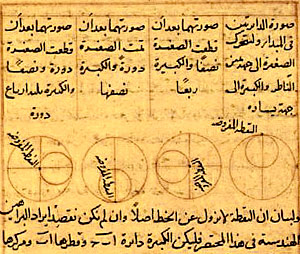
The Maragha Revolution
In 1258 the Mongol Hulagu Khan’s army besieged the walls of Baghdad, sacking the city. The Mongols massacred thousands, and destroyed mosques, palaces, hospitals, and libraries destroying their priceless books. This marked the end of the Islamic Golden Age.
In the thirteenth century, Nasir al-Din Tusi (1201–1274) convinced the Mongol conqueror Hulagu to build a new observatory in Maragha, in modern-day Azerbaijan. Astronomical work at this “Maragha School” began a tradition that continued in Damascus and Samarkand. As already noted, astronomy held an important place in Islamic culture because, in addition to aiding in navigation, it helped determine the times of prayer, when the fasting month of Ramadan began and ended, and the direction of the qibla (the Kaaba in Mecca that Muslims face when praying). The Maragha Revolution was against Ptolemaic astronomy, providing a critical examination and correction of Ptolemy’s astronomical data, and adding important and crucial astronomical observations. Tusi was the first to provide data proving the Earth’s rotation and to present trigonometry as a separate mathematical discipline.

Tusi’s most influential book in the West may have been Tadhkirah fiʿilm al-hayʿa (Treasury of Astronomy), which describes a geometric construction, now known as the Tusi couple, explained by Al-Khalili as “a small circle revolving around the inner rim of a larger circle twice its diameter. The clever feature is that a point on the circumference of the smaller circle will be seen to oscillate back and forth in linear motion along a diameter of the larger circle. By means of this construction, al-Tūsi succeeded in reforming the Ptolemaic planetary models, by doing away entirely with the awkward equants.”
Other important astronomers include Ibn al-Shatir, Ali Qushji, Al-Birjandi and al-Khafri. The revolution led to a movement away from the philosophical foundations of Aristotelian cosmology and Ptolemaic astronomy to a greater emphasis on empirical observation and the insistence on the need to employ mathematics to describe and predict planetary positions and nature as a whole.
The Tusi couple, together with the new solar and lunar theories of Ibn al-Shatir, had a decisive impact on Copernicus, who used these mathematical strategies even to the point of employing very similar figures to those used by Tusi in his couple, as well as the Latin equivalents of the Arabic characters. Of course, Copernicus was not the first one to present heliocentricity (the idea that the Earth moved around the sun rather than vice versa); that concept had been around as a fringe idea for two millennia. But Copernicus could not have arrived at his final heliocentric model without the work of the Islamic astronomers at Maragha.
External Stories and Videos


Watch: Science & Islam
BBC full series with Jim Al-Khalili
The history of Islamic science and it’s subsequent spread through Europe.
